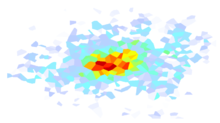shakelib.directivity.bayless2013¶
- class shakelib.directivity.bayless2013.Bayless2013(origin, rup, lat, lon, depth, T)[source]¶
Bases:
objectImplements the Bayless and Somerville (2013) directivity model. This is an update to Somerville et al. (1997), which defines some of the input parameters.
Fd is the directivity effect parameter, and it is evaluated as
Fd = (c0 + c1 * Fgeom) * Tcd * Tmw * Taz
Note that Fd is intended to be used in GMPEs as:
ln(IM_dir) = ln(IM) + Fd
where
Fd is the directivity effect
IM is the intensity measure predicted by the GMPE.
IM_dir is the directivity-adjusted IM.
The model is seprated into strike-slip and dip-slip categories: SS: (abs(rake) > 0 & abs(rake) < 30) | (abs(rake) > 150 & abs(rake) < 180) DS: abs(rake) > 60 & abs(rake) < 120
Notes from Somerville et al. (1997):
d = length of dipping fault rupturing towards site
Y = d/W
s = length of striking fault rupturing towards site
X = s/L
Bayless and Somerville state that each quadrilateral should have a pseudo- hypocenter:
“Define the pseudo-hypocenter for rupture of successive segments as the point on the side edge of the fault segment that is closest to the side edge of the previous segment, and that lies half way between the top and bottom of the fault. We assume that the fault is segmented along strike, not updip. All geometric parameters are computed relative to the pseudo-hypocenter.”
To do:
Interpolate for arbitrary periods
Inherit from Directivity base class.
References
Bayless, J., and Somerville, P. (2013). Bayless-Somerville Directivity Model, Chapter 3 of PEER Report No. 2013/09, P. Spudich (Editor), Pacific Earthquake Engineering Research Center, Berkeley, CA. [link]
Somerville, P. G., Smith, N. F., Graves, R. W., and Abrahamson, N. A. (1997). Modification of empirical strong ground motion attenuation relations to include the amplitude and duration effects of rupture directivity, Seismol. Res. Lett. 68, 199–222. [link]
Constructor for bayless2013.
- Parameters:
origin – Shakemap Origin object.
rup – Shakemap Rupture object.
lat – Numpy array of latitudes.
lon – Numpy array of longitudes.
depth – Numpy array of depths (km); down is positive.
T – Period; Currently, only acceptable values are 0.5, 0.75, 1, 1.5, 2, 3, 4, 5, 7.5, 10.
